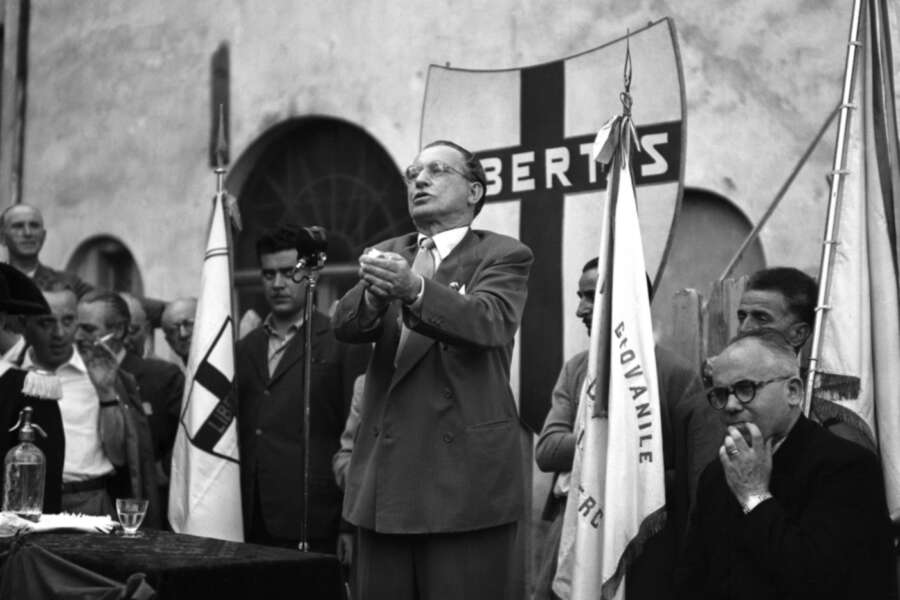As in France, Italian Christian democracy was largely based on the ideas of the Resistance Movement. The formation of Christian democracy in Italy was largely due to the personal influence of Alce de Gasperi.
After the First World War, Alce de Gasperi was elected to the Italian Parliament from the Italian People’s Party. The rise to power of the Fascists and the banning of the Italian People’s Party turned Alce de Gasperi into one of the critics of the totalitarian regime. De Gasperi was arrested. It was only through the intervention of the Catholic Church hierarchs that de Gasperi was granted amnesty. For a long time after his release from prison, Alce de Gasperi could not find a job until he took a low-profile position in the Vatican library.
In early 1943, Alce de Gasperi published a manifesto entitled Ideas for the Reconstruction of Christian Democracy. In this document, de Gasperi proposed the restoration of postwar Italy on the principles of parliamentarism, guaranteeing civil and political freedoms, and implementing social reforms on a Christian basis. The document envisaged the introduction of universal suffrage, including for women, granting autonomy to the regions, reforming industry, increasing the role of workers, reforming agriculture and the tax system, and encouraging the process of rapprochement between European nations on the basis of Christian values.
During 1943, a significant number of Christian groups of the Resistance Movement and anti-fascist “white partisan groups” emerged in Italy. The Ideas for the Reconstruction of Christian Democracy became a kind of ideological tool for those partisan groups that did not share communist or socialist beliefs.
By the end of 1943, the Christian Democrats had already established a political party. Alce de Gasperi was elected chairman of the party. The newly formed Christian Democratic Party joined the Communists and Socialists in a coalition government.
In the first post-war elections in Italy, the Christian Democratic Party gained 48.5% of the vote, which was 17% more than the bloc of communists and socialists. Prior to the 1992 elections, the Italian Christian Democrats had formed governments either independently or in coalition with other parties.
Support for the Christian Democrats in the Italian parliamentary elections:
| Elections | Percentage | |
| 1946 | 35,21 % | |
| 1948 | Lower House | 48,51 % |
| Senate | 48,11 % | |
| 1953 | Lower House | 40,10 % |
| Senate | 39,76 % | |
| 1958 | Lower House | 42,35 % |
| Senate | 41,23 % | |
| 1963 | Lower House | 38,28 % |
| Senate | 36,47 % | |
| 1968 | Lower House | 39,12 % |
| Senate | 38,34 % | |
| 1972 | Lower House | 38,66 % |
| Senate | 38,07 % | |
| 1976 | Lower House | 38,71 % |
| Senate | 38,88 % | |
| 1979 | Lower House | 38,30 % |
| Senate | 38,34 % | |
| 1983 | Lower House | 32,93 % |
| Senate | 32,41 % | |
| 1987 | Lower House | 34,31 % |
| Senate | 33,62 % | |
| 1992 | Lower House | 29,66 % |
| Senate | 27,27 % | |
Christian democrats have actually become hostages to the specifics of Italian political culture. In postwar Italy, two “political subcultures” existed in parallel: Catholic and socialist-communist. The voters of both “subcultures” existed in different symbolic fields and practically did not overlap. Catholic voters would not vote for left-wing parties under any circumstances, and voters of left-wing parties would not vote for Christian Democrats or other right-wing parties.
In most countries, this polarization is balanced by a significant number of “undecided voters” who can vote for one party or the other on a moment’s notice. In Italy, however, such a field practically did not exist. Both the Christian Democrats and the Communists and Socialists had their own stable electorate, which remained virtually unchanged throughout all election cycles.
The death of Alce de Gasperi and the gradual withdrawal of the first generation of Christian Democrats brought a new, more pragmatic and cynical generation of politicians to the forefront.
Author: Konstantin Kanishev




